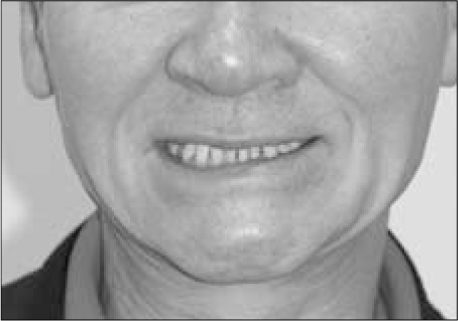Articles
- Page Path
- HOME > Restor Dent Endod > Volume 35(1); 2010 > Article
- Basic Research Mouthguard for relief of repeated clenching stress to cervical restorations during exercises
- Sung-Young Yoon, Chang-Kyu Song, Se-Hee Park, Jin-Woo Kim, Kyung-Mo Cho
-
2010;35(1):-23.
DOI: https://doi.org/10.5395/JKACD.2010.35.1.020
Published online: January 31, 2010
Department of Conservative Dentistry, College of Dentistry, Gangneung-Wonju National University, Korea.
- Corresponding Author: Kyung-Mo Cho. Department of Conservative Dentistry College of Dentistry, Gangnung-Wonju National University, 123 Chibyon-dong, Gangneung, Gangwon-do, 210-702, Korea. Tel: 82-33-640-2470, Fax: 82-33-642-6410, drbozon@gwnu.ac.kr
• Received: November 17, 2009 • Revised: December 24, 2009 • Accepted: December 30, 2009
Copyright © 2010 Korean Academy of Conservative Dentistry
- 814 Views
- 3 Download
- 4 Crossref
Abstract
-
Mouthguards were used to protect boxers from lip lacerations and other soft tissue injuries in the late 19th century. Now they are used various parts of dental treatment, which are sports protective aid, bleaching tray, orthodontic retainer, implant insertion guide tray, splint and so on.Repeated dislodgement of Class V restoration due to habitual clenching stress should be restored with stress control. Mouthguard can be used as stress relief device.This case describes methods that can relieve occlusal force to teeth by using mouthguard.Satisfactory results can be obtained by using mouthguard for retention of repeated dislodgement Class V restorations.If patients suffered from repeated restorations of Class V due to clenching, mouthguard can be used additional device to relieve the occlusal stress in conservative dentistry.
- 1. Grippo JO, Simring M, Schreiner S. Attrition, abrasion, corrosion and abfraction revisited: A new perspective on tooth surface lesions. J Am Dent Assoc. 2004;135: 1109-1118.PubMed
- 2. Bernhardt O, Gesch D, Schwahn C, Mack F, Meyer G, John U, Kocher T. Epidemiological evaluation of the multifactorial aetiology of abfractions. J Oral Rehabil. 2006;33: 17-25.ArticlePubMed
- 3. Andreasen JO, Andreasen FM, Andersson L. Textbook and Color Atlas of Traumatic Injuries to the Teeth. 2007;4th edition. 817-820.
- 4. Yokoyama Y, Ishijima T, Hirai T. Involuntary clenching during elbow flexion exercise. J Jpn Soc Stomatognath Funct. 1996;3: 67-72.Article
- 5. Emura I, Maeda Y, Ohtani T, Okada M, Nokubi T, Okuno Y, Onoue Y, Maeada N, Yoshioka W, Tsutsumi S. Clinical application of T-Scan System. 2. Evaluation of soft mouthguards. Osaka Daigaku Shigaku Zasshi. 1990;35: 441-446.PubMed
- 6. Takeda T, Ishigami K, Nakajima K, Naitoh K, Kurokawa K, Handa J, Shomura M, Regner CW. Are all mouthguards the same and safe to use? Part 2. The influence of anterior occlusion against a direct impact on maxillary incisors. Dent Traumatol. 2008;24(3):360-365.PubMed
REFERENCES
Tables & Figures
REFERENCES
Citations
Citations to this article as recorded by 

- Investigation of the Effects of Teeth Clenching Due to Weight Training on Oral Health
Sang Min Lee, Eun Chae Lee, Juwon Gong, Chae Eun Jang, Young Sun Hwang
Journal of Dental Hygiene Science.2024; 24(3): 152. CrossRef - Sports-Related Oral and Maxillofacial Injuries: A 5-Year Retrospective Study, Pusan National University Dental Hospital
Han-Kyul Park, Jin-Young Park, Na-Rae Choi, Uk-Kyu Kim, Dae-Seok Hwang
Journal of Oral and Maxillofacial Surgery.2021; 79(1): 203.e1. CrossRef - Influencing factors on oral and maxillofacial trauma prevention education experience of students majoring in physical education
Kyeung-Ae Jang
Journal of Korean society of Dental Hygiene.2014; 14(6): 915. CrossRef - Correlation between maxillofacial injury, use of mouth guards and stress in physical education majoring male students
Jong-Hwa Jang, Jee-Hee Kim
The Korean Journal of Emergency Medical Services.2013; 17(2): 89. CrossRef
Mouthguard for relief of repeated clenching stress to cervical restorations during exercises







Figure 1
Clenching habit during exercise.
Figure 2
Customized mouthguard.
Figure 3
Occlusal analysis by T-Scan II.
Figure 4
Difference appearance of occlusal analysis with/without mouthguard.
Figure 5
No restoration dislodgement during 1 year 5 month.
Figure 6
Mouthguard made by laminated technique.
Figure 7
Deformed mouthguard.
Figure 1
Figure 2
Figure 3
Figure 4
Figure 5
Figure 6
Figure 7
Mouthguard for relief of repeated clenching stress to cervical restorations during exercises

 KACD
KACD







 ePub Link
ePub Link Cite
Cite

